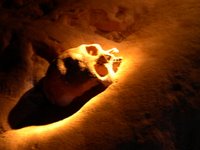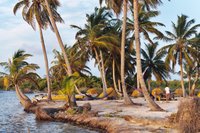Belize
My first trip was in April 2004. I travelled to Belize, which is the old British Honduras and is located in Central America. Belize is a land of jungles and sea. Our group of 12, Americans and Canadians, enjoyed camping on a deserted island,
 snorkeling, ocean kayaking and river kayaking through the jungle.
snorkeling, ocean kayaking and river kayaking through the jungle.We spent our first day hiking through the jungle until we reached an area called Aktun Tunichil Muknal, where there was a cave with an underground river. We had to swim through a pool of water to gain access to the cave; hiking and swimming to reach the huge openings where we found Mayan ceremonial artifacts and human sacrificial remains.


We took a boat from Dangriga, which dropped us off on a deserted island near Tobacco Caye. Here, we spent two days kayaking, snorkeling and crocodile hunting.
 The next couple of days were spent on Glover's Reef, where we slept in beach front cabanas. We spent lazy days snorkeling and fishing.
The next couple of days were spent on Glover's Reef, where we slept in beach front cabanas. We spent lazy days snorkeling and fishing. 
Then it was back to Dangriga. After arriving, we drove to the Banana Bank Lodge on the Belize River. We had our first real showers in days and some delicious meals. I enjoyed horse back riding and exploring the grounds of the river front plantation. The evening was spent watching the fireflies and listening to the howler monkeys and all the other jungle life.
We spent the next four days on the Macal River swimming and kayaking through the jungle and camping on the river bank. Led by discoverer Greg Sho, we explored old Mayan sights. Greg had spent the past years documenting the river and wildlife in an attempt to halt plans of a massive hydroelectric project that will threaten the tropical wildlife. As we hiked and kayaked, he pointed out the many S carlet Macaws, iguanas, green parrots and snakes. On a kayak, Greg silently
carlet Macaws, iguanas, green parrots and snakes. On a kayak, Greg silently  paddled through the darkness of the night, manuevering under trees and around rocks that I didn't know were there to approach crocodiles, tapirs, and iguanas.
paddled through the darkness of the night, manuevering under trees and around rocks that I didn't know were there to approach crocodiles, tapirs, and iguanas.
After three nights of sleeping on the hard ground,  cooking over a fire and being eaten up by ticks, we needed the night at Pook's Hill Lodge. There, we had our own shower, a real bed, drinks in the bar, and a delicious dinner, bringing our stay in Belize to an end.
cooking over a fire and being eaten up by ticks, we needed the night at Pook's Hill Lodge. There, we had our own shower, a real bed, drinks in the bar, and a delicious dinner, bringing our stay in Belize to an end.
























